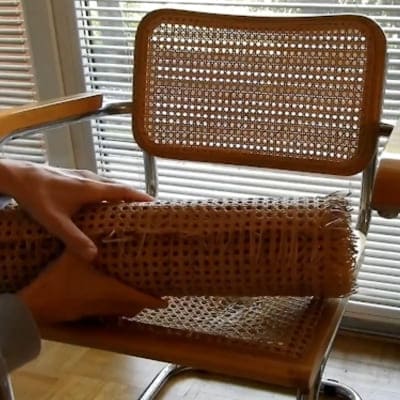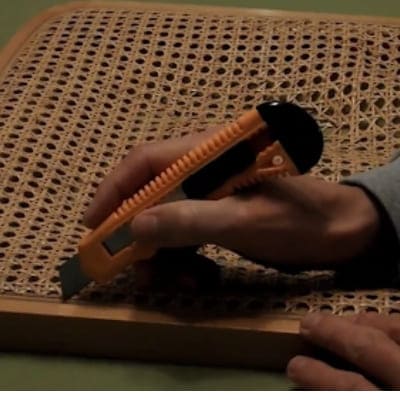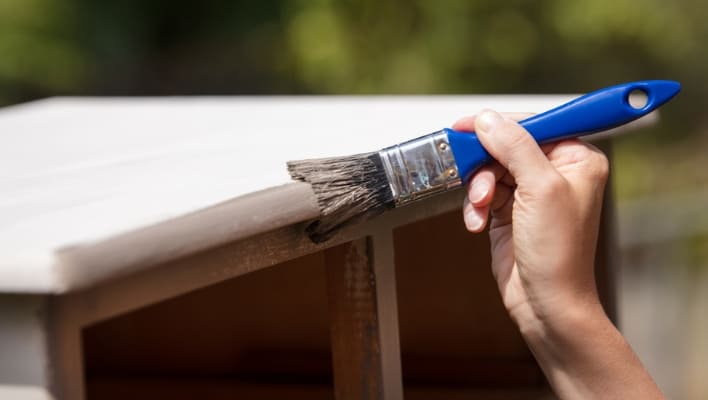How beautiful rattan furniture can be, indeed! Its natural charm makes rattan furniture popular for both indoors and outdoors. However, over time, rattan furniture may show signs of wear and tear.
If you’re wondering how to repair rattan furniture, you must know that with the right guidance, you could easily restore it to its former glory. You could also enjoy its unique beauty for years to come. Whether you have a cherished sentimental piece or a favorite item that has seen better days, this guide will walk you through the steps to bring your rattan furniture back to life.

Table of Contents
- How To Repair Rattan Furniture?
- Gather Your Materials
- 1. Prepare the Rattan
- How to fix a hole in rattan furniture?
- 2. Cut Off Broken Rattan
- 3. Reattach Loose Pieces
- 4. Weave Damaged Areas
- 5. Sand and Smooth
- 6. Paint or Stain (Optional)
- Wrapping Up
- FAQs On How To Repair Rattan Furniture
- Q. Can I glue rattan?
- Q. Does wood glue work on rattan?
- Q. Is it worth repairing rattan furniture?
- Q. What is the difference between rattan and synthetic rattan?
- Rosalie Sanchez
How To Repair Rattan Furniture?
Natural rattan furniture demands extra maintenance and attention due to its vulnerability to the growth of mold, reported by Jennifer Ebert (Digital Editor at Homes & Gardens).
I am fond of rattan furniture, and most of my home furniture is crafted from this exquisite material. However, my backyard rattan chairs with wicker weave have started to show signs of wear and tear due to harsh weather.
To cope with this issue, I also felt distressed, wondering how to repair wicker furniture. If you find yourself in a similar situation, let me share some specific steps I followed, especially when it’s used outdoors.

Gather Your Materials
- Rattan reed or cane
- Wood glue or epoxy adhesive
- Fine-grit sandpaper
- Paint or stain (if needed)
- A small paint brush or sponge
- Clamps
- Scissors
- Damp cloth
1. Prepare the Rattan
Start by cleaning your rattan furniture thoroughly to remove dust and dirt with a damp cloth. The affected areas can be gently scrubbed with a mild detergent and water mix for stubborn stains. For cleaning my rattan chairs, I used Murphy’s oil soap to clean them effectively. Rinse off the furniture with clean water.
How to fix a hole in rattan furniture?
Fixing a hole in rattan furniture could be a delicate process, but it’s certainly possible with some patience and the right materials. With these below steps, you can repair both minor damage and small holes in plastic rattan or natural rattan furniture, extending its lifespan and preserving its appearance.
- Clean the hole: Begin by cleaning the hole with a mixture of mild soap and water. Ensure it’s free from dirt and debris.
- Soak rattan reeds: If you have rattan reeds available, soak them in warm water until they become pliable.
- Insert rattan reeds: Carefully thread the soaked rattan reeds through the hole, pushing and weaving them to mimic the existing rattan pattern. Use a small tool or tweezers to help with this process.
- Secure with adhesive: Apply a small amount of wood glue or epoxy resin to the ends of the inserted rattan reeds to hold them in place.
- Trim and blend: Trim any excess rattan reeds and use sandpaper to smooth the repaired area. If necessary, paint or apply a matching finish to ensure the repair blends with the rest of the rattan furniture.
2. Cut Off Broken Rattan

Carefully inspect your rattan furniture for any loose ends, broken weaving, or damaged joints. Make a list of all the areas that need to be repaired.
If you discover broken or frayed rattan strands that cannot be repaired, use scissors or pruning shears to carefully trim away the damaged sections. This will prevent further unraveling and make it easier to replace the damaged pieces.
3. Reattach Loose Pieces

Once the loose rattan ends are fully clean and dry, apply a generous amount of wood glue or epoxy adhesive to the ends that need reattachment. For this purpose, I would recommend Gorilla Wood Glue, the best glue for repairing rattan furniture. I was pleased with how well the wood glue repaired my rattan chair.
After applying a generous amount to the loose rattan ends and carefully pressing them back into place, I secured them with clamps to ensure a tight bond. The adhesive held remarkably well, and I could feel the pieces coming together with each clamp. I left the clamps in place for the recommended drying time, and the next day, I was able to remove them with confidence.
4. Weave Damaged Areas
Measure and cut the rattan reed or cane to the appropriate length for the damaged area. I opted for a Wicker plastic rattan repair kit for the durability and seamless repair it offers. The rattan reed or cane in the kit was of high quality and the strands were strong and flexible, making them easy to work with.
Soaking the new cut pieces of rattan reed or cane in warm water for about 30 minutes is an excellent technique to make them more flexible, which is essential for weaving damaged areas effectively. Begin weaving by threading the soaked rattan reed through the existing rattan strands, following the original pattern. Use a weaving technique that matches the design of your rattan furniture.
When you reach the end of the repair area, secure the rattan reed by tucking it under the existing strands or using wood glue or epoxy for extra reinforcement.
As the glue dried, you could see the rattan strands bonding securely, and there would be no sign of the repaired sections coming apart. As in my DIY project, the result was a strong and sturdy repair that looked almost as good as new.
5. Sand and Smooth
After all the repairs are complete and the adhesive has dried, use fine-grit sandpaper to smooth out any rough edges, excess glue, or uneven surfaces. Sand the repaired areas until they are flush with the rest of the furniture. You can follow the same steps for plastic rattan furniture.
6. Paint or Stain (Optional)

If your rattan furniture has lost its original color or you want to give it a fresh look, choose a paint or stain that is suitable for rattan. Apply a fine smooth coat and leave it until it gets dried. You can repeat this step for additional coats if needed.
Wrapping Up
With my comprehensive guide on how to repair rattan furniture enriched with personal expertise, you can fix your rattan furniture, whether it’s indoors or outdoors. By taking the time to care for and restore your beloved rattan pieces, you can continue to enjoy their unique beauty for many more years to come.
FAQs On How To Repair Rattan Furniture
Q. Can I glue rattan?
Yes, you can glue rattan. I suggest using Gorilla Wood Glue for this purpose. It’s a strong adhesive that bonds well with rattan and is suitable for various woodworking projects.
Q. Does wood glue work on rattan?
Wood glue is indeed a versatile adhesive that can work effectively on rattan. If you have rattan furniture that has come apart or developed loose joints, wood glue can be an excellent choice for rejoining the pieces.
Q. Is it worth repairing rattan furniture?
Rattan furniture can be a unique and stylish addition to your home or outdoor space, and it often carries sentimental value. If the piece holds sentimental or aesthetic significance, or if it’s a high-quality, durable item, repairing it can be a worthwhile investment. Replacing rattan furniture can be quite costly, so opting for repairs might offer a more economical solution.
Q. What is the difference between rattan and synthetic rattan?
Natural rattan furniture tends to offer superior comfort when compared to synthetic rattan. This enhanced comfort is a result of the weave’s tightness. Conversely, synthetic rattan, often featuring an added hardened coating, might not be the same at the level of comfort.

Rosalie Sanchez
DIY enthusiast with years of experience in home decor and home improvement. With a passion for educating consumers about DIY projects. Every time, I work with our painting professionals to provide you with the best painting product reviews and how-to advice. You can follow me on Facebook.


